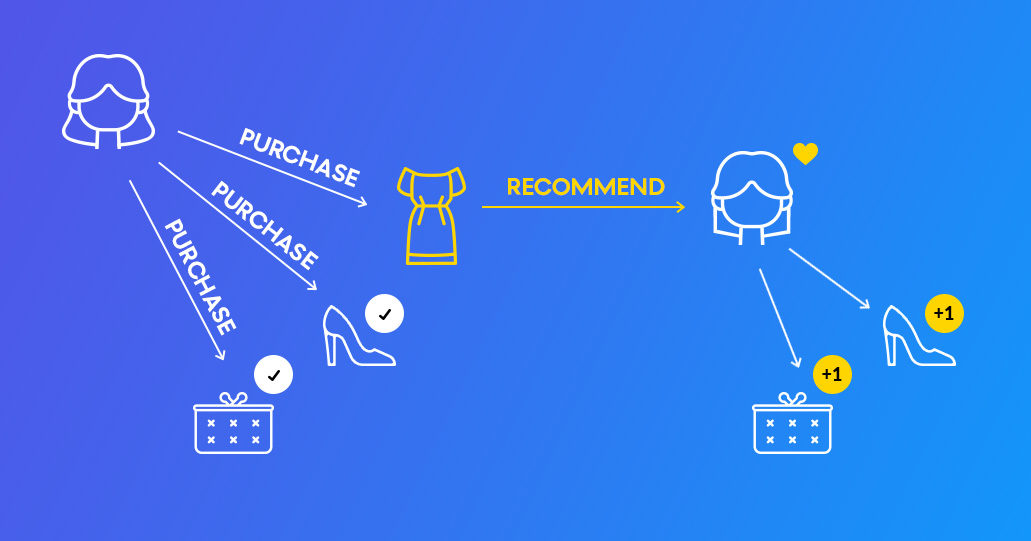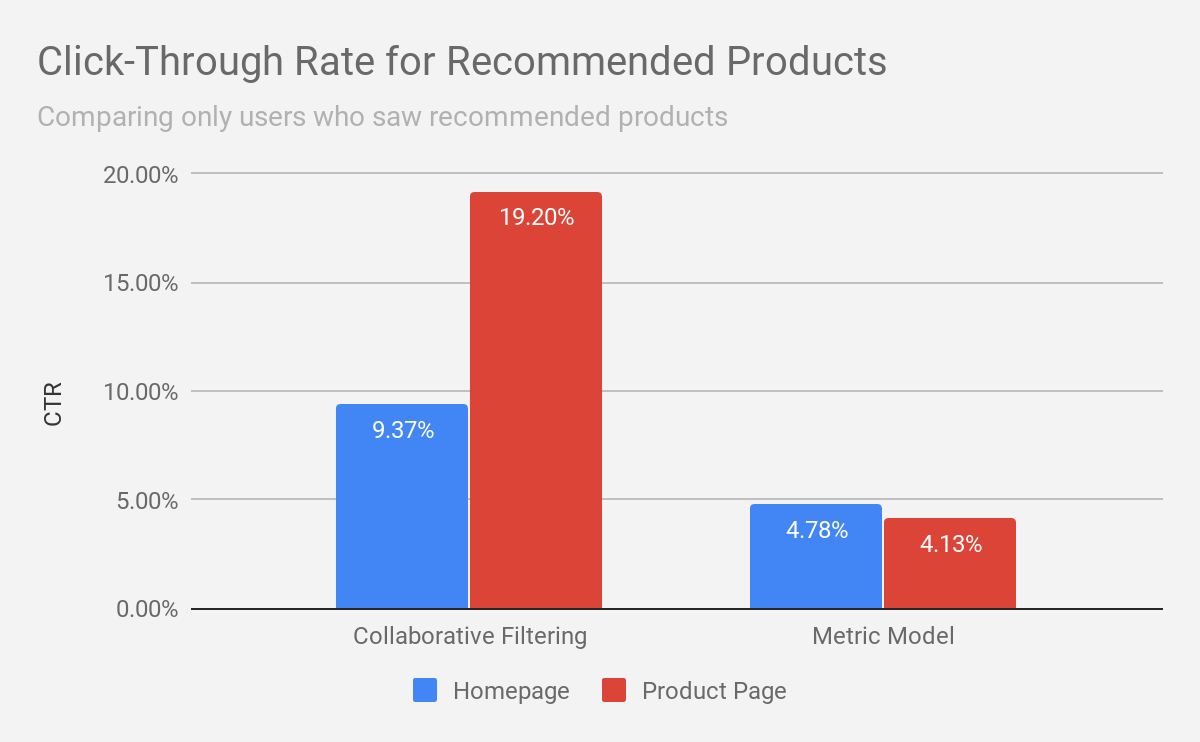Using Exponea’s collaborative filtering model for product recommendations, a fashion e-commerce company was able to increase on-site personalization, more than double their click-through rate for recommended products, and increase recommended products added to the shopping basket by 20%.
Today’s customers expect personalized shopping experiences. One of the largest Czech fashion e-shops (we’ll call them “Alpha”), knows this well. Alpha offers a wide range of clothes and accessories for men and women, focusing on stylish and high quality products from unique brands. With a large range of products and an even larger customer base, Alpha has a large amount of data at their disposal. As a young, innovative brand, Alpha prides themselves on their ability to use their data to improve the customer journey.
For more than two years Exponea has worked with Alpha on creating successful campaigns, overcoming difficult scenarios, and building new features. So when they were looking for a way to improve their product recommendations, they turned to Exponea for help turning their data into an excellent shopping experience.
Let’s take a closer look at what Alpha wanted to achieve, and how Exponea helped.
Listen to this article
The Situation
Alpha’s vast product portfolio is undoubtedly part of the brand’s appeal. But with so many products available, only a fraction of their catalog will be relevant to any given shopper. This makes it difficult to get the right items in front of the right customers. Knowing which products will be most interesting to which customers is no small feat, especially with such a large customer database.
The problem, then, is one of personalization. How do you recommend products to customers that they’ll actually want to purchase? And how do you avoid showing them products that they don’t want to see?
Why Is This Important?
There are three industry-standard locations for recommended products on e-shops:
- On the homepage
- On the product page
- In the shopping basket
By offering personalized product recommendations in these three places, Alpha hoped to see success in a few key areas:
Smoother, faster shopping experience: putting interesting products right on the homepage means the customer doesn’t need to click through multiple sections of the website to find what they want.
Cross-selling and up-selling opportunities: customers on fashion e-shops often buy more than one item. Showing personalized suggestions right on the product page of something they already want to purchase could increase the number of items in the shopping basket.
Happier customers: no customer wants to see products that don’t interest them—and customers will keep coming back to a shop that shows them what they want to see.
Failure to show compelling recommended products would mean missed sales, decreased time spent on the site, and frustrated customers.
Previous Solutions
Because placing the right item into these recommended product spots can have such an impact, many e-commerce sites created models to try to determine what to place there. Many of these models are still commonly found on e-commerce sites today.
Some of the most popular models place best-selling or recently viewed items in the recommended product areas. These simple models are popular because they can be implemented very easily. No special software is required, nor do they require carefully managed customer data. Due to their use of easily obtained metrics, we’ll call them metric models.
Although metric models are easy to implement, they don’t offer much in the way of personalization. Best-selling items are the same for all customers, and recommending recently viewed items doesn’t offer anything in the way of cross-selling or up-selling. For Alpha to offer a truly personalized shopping experience, they’d need to move beyond the relatively basic metric models.
Exponea’s Solution — Collaborative Filtering
Thanks to Alpha’s long partnership with Exponea, Alpha has a well-managed database of customer information. This in-depth knowledge of customers meant Exponea could build a new recommendation system that would be more personalized and more effective.
This new system would rely on collaborative filtering models—a way of predicting purchasing behavior by grouping similar customers together. Here’s a simplified version of how it works:
Customers Janet and Denise are both women around the same age who like to shop at Alpha.
Janet and Denise both bought the same pair of sunglasses and the same high-heels.
Denise later buys some sneakers.
Because Janet and Denise have bought similar items in the past, the collaborative filtering model will now recommend the sneakers Denise bought to Janet.

Using machine learning and predictive analytics, collaborative filtering groups similar customers together in order to make more personalized product recommendations. The collaborative filtering model was used as a template for making product recommendations on the homepage, on the product page, and in the shopping basket. More advanced models (such as recommending products that were the same color as what the customer was already viewing) were also implemented, using collaborative filtering as a base.
The success of the new model relied on clear goal-based communication with Exponea. Collaborative filtering needs clear data structures, appropriate time ranges for training the filters, and a well-understood hypothesis. After implementation, testing and iteration are also necessary. Exponea provided the critical support necessary for Alpha to see the success of their new personalized recommendation models.
After a full-scale testing and implementation of the models, the results were clear. Collaborative filtering worked, and Alpha was now able to offer a more personalized shopping experience.
Let’s see what their success looked like.
The Results
To see the impact of collaborative filtering, we’ll compare it to the success of the old metric models. First, let’s see how many more people were clicking on recommended products after collaborative filtering was introduced. The results tell a clear story.

Introducing collaborative filtering models more than doubled the click-through rate for recommended products on the homepage, product page, and shopping basket.
While that’s an impressive increase, the overall click-through rate here doesn’t tell the whole story. In order to see their personalized product recommendations, customers have to scroll down on both the homepage and the product page. But only about 10% of customers actually scroll down to see their recommended products. So for a better understanding of how successful collaborative filtering is compared to metric models, we should only compare users who actually scrolled down and saw the recommended products.
Doing so reveals just how powerful personalization can be.

Once again, collaborative filtering doubled the click-through rate for recommended products on the homepage. But more impressively, there was a 460% click-through rate increase for recommended products on the homepage, compared to the metric model! Clearly customers find personalized recommendations on the homepage far more interesting than bestsellers or recently viewed items.
But not only did collaborative filtering-powered recommendations create more clicks—the targeted recommendations also resulted in more items added to the shopping basket. Customers were 10% more likely to add products suggested by collaborative filtering to their shopping basket. Increased personalization means more relevant recommendations, which leads to more purchases.
Alpha knows each customer is different, and should be treated as an individual. Thanks to collaborative filtering and a strong partnership with Exponea, Alpha’s customers can enjoy a smoother, more personalized shopping experience.
Want more? We’ve got you covered
What Should You Read Next? Author's Hand-Picked Recommendation:
Your Customers Want an Experience. Give it to Them.
86% of customers are willing to pay more for a better customer experience. Give them what they want.




 Blog
Blog
 Spotify
Spotify SoundCloud
SoundCloud Apple Podcasts
Apple Podcasts Google Podcasts
Google Podcasts Stitcher
Stitcher Anchor
Anchor






